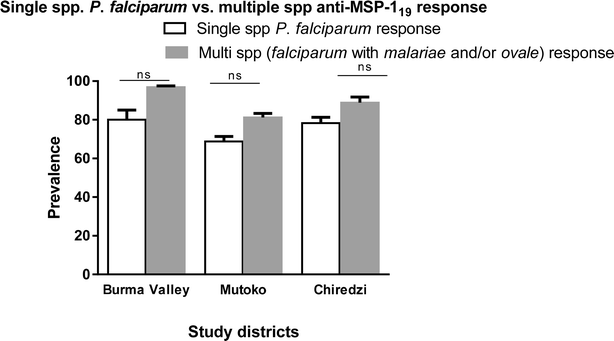Seroepidemiology of Plasmodium species infections in Zimbabwean population
- PMID: 27165412
- PMCID: PMC4863323
- DOI: 10.1186/s12936-016-1325-3
Seroepidemiology of Plasmodium species infections in Zimbabwean population
Abstract
Background: Individuals living in malaria-endemic regions may be exposed to more than one Plasmodium species; there is paucity of data on the distribution of the different species of Plasmodium in affected populations, in part due to the diagnostic method of microscopy, which cannot easily differentiate between the species. Sero-epidemiological data can overcome some of the shortcomings of microscopy.
Methods: The specificity of IgG antibodies to recombinant merozoite surface protein 1 (MSP-119) derived from four human Plasmodium species (Plasmodium falciparum, Plasmodium vivax, Plasmodium malariae, Plasmodium ovale) was investigated using competition enzyme-linked immunosorbent assay. Subsequently, these antigens were used to determine the exposure prevalence to the different Plasmodium species in serum samples of participants. One-hundred individuals, aged five-18 years, from each of the three Plasmodium meso-endemic Zimbabwean villages (Burma Valley, Mutoko, Chiredzi) were recruited in the study.
Results: The study demonstrated that the host serum reactivity to MSP-119 antigens was species-specific and that no cross-reactivity occurred. The overall prevalence of antibody response to MSP-119 antigens was 61 % in Burma Valley, 31 % in Mutoko and 32 % in Chiredzi. Single species IgG responses to MSP-119 were most frequent against P. falciparum, followed by P. malariae and P. ovale, with responses to P. vivax being the least prevalent. Interestingly, 78-87 and 50 % of sera with IgG responses to P. malariae and P. ovale MSP-119, respectively, also had IgG specific response for P. falciparum MSP-119 antigens, indicating that exposure to these species is a common occurrence in these populations. Single species IgG responses to the non-falciparum species were at a very low frequency, ranging between 0 and 13 % for P. malariae.
Conclusions: There is evidence of a higher exposure to the non-falciparum parasite species than previously reported in Zimbabwe. The recombinant MSP-119 antigens could be used as additional diagnostic tools in antibody assays for the detection of exposure to the different Plasmodium species. The results also introduce an interesting concept of the co-infection of non-falciparum Plasmodium almost always with P. falciparum, which requires further validation and mechanistic studies.
Keywords: Antibody; Merozoite surface protein 1 (MSP-119); Microscopy; Plasmodium.
Figures


References
-
- WHO. World Malaria Report 2013. Geneva: World Health Organization; 2013.
Publication types
MeSH terms
Substances
Grants and funding
LinkOut - more resources
Full Text Sources
Other Literature Sources
Medical
Research Materials

